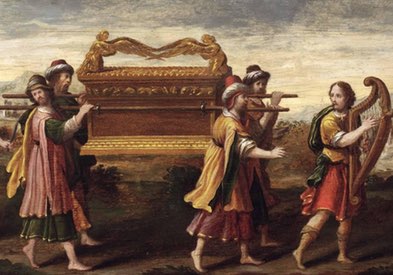August 16, 2017
Paulist Fr. Rich Andre preached this homily for Solemnity of the Assumption of the Blessed Virgin Mary on August 15, 2017 at Westminster Nursing Home and St. Austin Parish in Austin, TX. The homily is based on the day’s readings: Revelation 11:19a, 12:1-6a; Psalm 45; 1 Corinthians 15:20-27; and Luke 1:39-56.
Many of us are familiar with the annual readings for the Solemnity of the Assumption of the Blessed Virgin Mary. Tonight, pay special attention to the first sentence of the first reading today, talking about the Ark of the Covenant.
The Church gives us the option to use different readings at the vigil Mass on the night before the Assumption. The first reading at the vigil tells of King David leaping for joy and offering sacrifices as the Ark of the Covenant is brought into the city of Jerusalem.
Why these mentions of the Ark of the Covenant? In the homily tonight, we’ll explain how St. Luke makes lots of subtle connections between the Ark of the Covenant and Mary.
One second reading, from one Paul’s letters, gives us another key to the theological significance of the Assumption. Let us give thanks to God who gives us the victory over death through our Lord Jesus Christ!
In the past 147 years since the doctrine of papal infallibilty was declared at the First Vatican Council, there has only been one instance of a pope making an infallible ex cathedra declaration. That was in 1950 when Pius XII declared the Assumption of the Blessed Virgin Mary into Heaven to be a dogma.
Now, let’s be clear: Pius XII did not just wake up one day and say, “Hey! This sounds like a good idea!” No, the belief that Mary was assumed into heaven dates to the early years of Christianity, with liturgical celebrations starting by the 5th century. Pius XII, in consultation with the bishops of the world, determined that this belief was so central to our understanding of salvation history that it should be declared a dogma of the Church.
Our evangelical neighbors find this odd. They ask us three questions. Where do you find the Assumption of Mary in the Bible? Do Catholics worship Mary? You believe that a doctrine about Mary is central to salvation?
Let’s address the first question. Why isn’t this mentioned in the Bible? The answer is: why would it be? Every book of the Bible was written for a specific purpose, and no book of the Bible was written to teach us about Mary. In telling us the story of Jesus Christ, Luke presents Mary as our role model, the first Christian. But he drops hints to indicate something more. Mary is overshadowed by the power of the Holy Spirit when she conceives Jesus. Elizabeth questions, “How does this happen… that the mother of my Lord should come to me?” Mary stays in the hill country of Judah for three months. In the Old Testament, one item is overshadowed by the cloud of God’s Spirit. It’s the Ark of the Covenant, the fancy container holding the most sacred objects of the Jewish people, including the stone tablets of the Ten Commandments. David questions, “How can the ark of the LORD come to me?” and he leaves the ark for three months in the hill country of Judah. According to Luke, Mary is the Ark of the New Covenant. She literally holds God’s promise – God’s very Word – within her body for 9 months.
So, to the second question: do Catholics worship Mary? No, just as the Israelites did not worship the Ark of the Covenant. We venerate Mary, as we venerate other saints. We honor Mary and other saints for two reasons: they are models for Christian discipleship and they are mirrors of Christ. Mary’s assumption into heaven by the power of God mirrors Christ’s ascension under his own power. As always, Mary points the way to Christ.
When it comes to answering the last question – why a belief about Mary is central to our salvation – we must think of Mary as a role model. We believe that Mary – a human being – now resides in heaven, body and soul. But “blessed are those who hear the word of God and observe it.” Today, we celebrate that we, too, will someday be in heaven, body and soul!
It’s easier to believe that only our souls will have eternal life. The resurrection of our bodies is harder to believe in, since we can’t comprehend how it will work. We’re no different than the early Corinthian Christians. They believed that Jesus Christ had been resurrected from the dead, but they struggled to believe that they would also be resurrected from the dead. Paul addresses these doubts head on. We have been clothed in the immortality of baptism, and so our mortal bodies can share in Christ’s victory over death.
According Hebrews, the Ark of the Covenant contained three items: the tablets of the Ten Commandments, the priestly rod of Aaron, and an urn holding some manna. Isn’t that fascinating! Both the Ark of the Old Covenant and Mary, the Ark of the New Covenant, held God’s very Word, the symbol of true priesthood, and the bread from heaven.
As the Ark of the New Covenant assumes its rightful place in heaven, we celebrate that Christ has given us victory over death. Before we receive the bread from heaven once again, we will declare together that we believe in the resurrection of our bodies and our life in the world to come. Amen!
